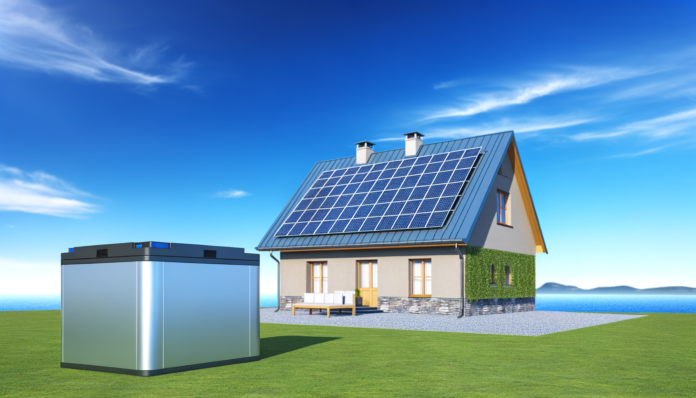Introduction to Solar Storage Systems
The Growing Need for Energy Independence
In today’s world, the demand for energy independence is more pressing than ever. With rising electricity costs, frequent power outages, and growing concerns about climate change, individuals and communities are seeking ways to reduce their reliance on traditional power grids. Solar storage systems offer a viable solution, enabling users to harness and store solar energy for use when needed, thus promoting self-sufficiency and sustainability.
Overview of Solar Power and Storage
Solar power is generated by converting sunlight into electricity using photovoltaic (PV) panels. However, the sun doesn’t shine 24/7, and energy needs often extend beyond daylight hours. This is where solar storage systems come into play. These systems store excess energy produced during the day in batteries or other storage mediums, allowing it to be used during the night or on cloudy days. By integrating storage solutions with solar power systems, users can ensure a continuous and reliable energy supply.
Benefits of Solar Storage Systems
The advantages of solar storage systems are numerous and impactful:
- Energy Independence: By storing solar energy, users can reduce their dependence on the grid, ensuring a steady power supply even during outages.
- Cost Savings: Storing and using solar energy can significantly lower electricity bills, as it reduces the need to purchase expensive grid electricity.
- Environmental Impact: Solar storage systems contribute to a reduction in carbon footprint by utilizing renewable energy sources and decreasing reliance on fossil fuels.
- Increased Efficiency: These systems optimize the use of generated solar power, minimizing waste and enhancing overall energy efficiency.
- Flexibility and Scalability: Solar storage solutions can be tailored to meet various energy needs, from small residential setups to large commercial installations.
In summary, solar storage systems are a crucial component in the transition towards energy independence and sustainability. They not only provide a reliable and cost-effective energy solution but also play a significant role in mitigating environmental impacts. As technology advances, the efficiency and accessibility of these systems are expected to improve, making them an increasingly attractive option for energy-conscious individuals and communities.
Types of Solar Storage Systems
Battery Storage Systems
Battery storage systems are the most common type of solar energy storage. These systems store the electricity generated by solar panels in batteries for later use. The most popular types of batteries used in solar storage are lithium-ion, lead-acid, and flow batteries.
- Lithium-Ion Batteries: Known for their high energy density and long lifespan, lithium-ion batteries are widely used in residential and commercial solar storage systems. They are efficient and have a relatively low self-discharge rate.
- Lead-Acid Batteries: These are the oldest type of rechargeable battery and are often used in off-grid solar systems due to their reliability and lower cost. However, they have a shorter lifespan and lower energy density compared to lithium-ion batteries.
- Flow Batteries: Flow batteries use liquid electrolytes to store energy, offering the advantage of scalability and long cycle life. They are particularly suitable for large-scale energy storage applications.
Battery storage systems provide several benefits, including energy independence, backup power during outages, and the ability to store excess solar energy for use during nighttime or cloudy days.
Thermal Storage Systems
Thermal storage systems capture and store solar energy in the form of heat. This stored thermal energy can be used for heating water, space heating, or even generating electricity through a heat engine. There are two main types of thermal storage systems:
- Molten Salt Systems: These systems use molten salt as a thermal storage medium. The salt is heated by solar energy and stored in insulated tanks. When electricity is needed, the stored heat is used to produce steam, which drives a turbine to generate electricity.
- Phase Change Materials (PCMs): PCMs store and release thermal energy during the process of melting and solidifying. They are used in various applications, including solar water heaters and building heating systems, to provide a stable and efficient thermal storage solution.
Thermal storage systems are particularly effective for applications requiring large amounts of heat and can provide a reliable source of energy even when solar radiation is not available.
Mechanical Storage Systems
Mechanical storage systems convert and store solar energy in mechanical forms, such as potential or kinetic energy. The two primary types of mechanical storage systems are:
- Pumped Hydro Storage: This system uses excess solar energy to pump water from a lower reservoir to an upper reservoir. When electricity is needed, the water is released back to the lower reservoir, driving turbines to generate electricity. Pumped hydro storage is highly efficient and can store large amounts of energy.
- Compressed Air Energy Storage (CAES): CAES systems use solar energy to compress air and store it in underground caverns or tanks. When electricity is needed, the compressed air is released and heated, driving a turbine to generate electricity. CAES systems are suitable for large-scale energy storage and can provide long-duration storage solutions.
Mechanical storage systems offer the advantage of long-term energy storage and can be integrated with other renewable energy sources to provide a stable and reliable energy supply.
Emerging Technologies in Solar Storage
The field of solar storage is continually evolving, with new technologies emerging to improve efficiency, capacity, and cost-effectiveness. Some of the promising emerging technologies include:
- Solid-State Batteries: These batteries use solid electrolytes instead of liquid ones, offering higher energy density, improved safety, and longer lifespans. Solid-state batteries are expected to revolutionize the solar storage market in the coming years.
- Hydrogen Storage: Solar energy can be used to produce hydrogen through electrolysis. The hydrogen can then be stored and used in fuel cells to generate electricity. Hydrogen storage offers a clean and efficient way to store large amounts of energy.
- Supercapacitors: Supercapacitors store energy through electrostatic charge rather than chemical reactions. They offer rapid charging and discharging capabilities, making them suitable for applications requiring quick bursts of energy.
These emerging technologies hold the potential to enhance the performance and scalability of solar storage systems, paving the way for a more sustainable and energy-independent future.
Key Components of Solar Storage Systems
Solar Panels
Solar panels are the cornerstone of any solar storage system. These panels, typically made from silicon, convert sunlight into electricity through the photovoltaic effect. The efficiency of solar panels has significantly improved over the years, with modern panels capable of converting up to 22% of sunlight into usable electricity. **Monocrystalline** and **polycrystalline** are the two main types of solar panels, each with its own advantages and cost considerations. Monocrystalline panels are generally more efficient and space-efficient, while polycrystalline panels are more affordable.
Inverters
Inverters play a crucial role in solar storage systems by converting the direct current (DC) electricity generated by solar panels into alternating current (AC) electricity, which is used by most household appliances. There are three main types of inverters: **string inverters**, **microinverters**, and **power optimizers**. String inverters are the most common and cost-effective, but they can be less efficient if panels are shaded or dirty. Microinverters and power optimizers offer better performance in such conditions but come at a higher cost.
Batteries
Batteries are essential for storing the electricity generated by solar panels for later use. The most common types of batteries used in solar storage systems are **lithium-ion** and **lead-acid** batteries. Lithium-ion batteries are more efficient, have a longer lifespan, and require less maintenance compared to lead-acid batteries. However, they are also more expensive. **Flow batteries** and **saltwater batteries** are emerging technologies that offer promising alternatives with longer lifespans and lower environmental impact.
Charge Controllers
Charge controllers are vital for regulating the flow of electricity from the solar panels to the batteries, ensuring that the batteries are charged efficiently and safely. There are two main types of charge controllers: **Pulse Width Modulation (PWM)** and **Maximum Power Point Tracking (MPPT)**. MPPT controllers are more efficient as they continuously adjust the voltage to maximize the power output from the solar panels, whereas PWM controllers are simpler and more affordable but less efficient.
Monitoring Systems
Monitoring systems are essential for tracking the performance and efficiency of a solar storage system. These systems provide real-time data on energy production, consumption, and storage levels, allowing users to optimize their energy usage. Advanced monitoring systems, such as **SolarEdge ONE**, integrate weather forecasts and market prices of electricity to make intelligent decisions about when to store or sell surplus energy. This not only maximizes efficiency but also helps in reducing overall energy costs.
In summary, the key components of solar storage systems—solar panels, inverters, batteries, charge controllers, and monitoring systems—work together to harness, convert, store, and manage solar energy efficiently. Understanding these components and their functions is crucial for anyone looking to achieve energy independence through solar power.
Choosing the Right Solar Storage System
Assessing Your Energy Needs
Before investing in a solar storage system, it’s crucial to understand your energy consumption patterns. Start by examining your electricity bills to determine your average daily and monthly usage. Consider seasonal variations and peak usage times. Tools like energy monitors can provide real-time data, helping you identify which appliances consume the most power. This information will guide you in selecting a system that meets your energy requirements without over- or under-sizing.
Evaluating System Efficiency
Efficiency is a key factor in choosing a solar storage system. Look for systems with high-efficiency ratings for both solar panels and inverters. The efficiency of a solar panel is measured by its ability to convert sunlight into electricity, while inverter efficiency refers to how well it converts DC power from the panels into AC power for home use. High-efficiency systems may have a higher upfront cost but can offer better long-term savings and performance. Additionally, consider the round-trip efficiency of the storage system, which indicates how much energy is retained after storage and retrieval.
Considering Portability and Durability
Portability and durability are essential considerations, especially if you plan to use your solar storage system in various locations or under different conditions. Portable systems like the SolPad offer flexibility for off-grid adventures or emergency situations. Durability is equally important; look for systems with robust construction and weather-resistant features. Systems designed for harsh environments, such as those with solid-state batteries, can withstand extreme temperatures and physical impacts, ensuring longevity and reliability.
Budget and Cost Considerations
Budget is often the deciding factor when choosing a solar storage system. While high-end systems offer advanced features and higher efficiency, they come at a premium price. However, there are cost-effective options like the Expandable 3.1KW Solar Hybrid Kit, which allows for incremental upgrades. This flexibility enables you to start with a smaller system and expand as your budget allows. Additionally, consider the long-term savings on energy bills and potential tax incentives, such as the 30% federal tax credit, which can offset the initial investment.
By carefully assessing your energy needs, evaluating system efficiency, considering portability and durability, and factoring in budget constraints, you can choose a solar storage system that best suits your requirements and ensures energy independence.
Installation and Maintenance
DIY vs. Professional Installation
When it comes to installing solar storage systems, you have two primary options: **DIY installation** or **professional installation**. Each has its own set of advantages and considerations.
**DIY Installation**:
– **Cost Savings**: One of the most significant benefits of DIY installation is the potential for cost savings. By doing the work yourself, you can avoid labor costs associated with professional services.
– **Flexibility**: DIY installation allows you to work at your own pace and schedule, which can be particularly beneficial if you have a busy lifestyle.
– **Learning Experience**: Installing your own system can be a rewarding educational experience, giving you a deeper understanding of how your solar storage system operates.
**Professional Installation**:
– **Expertise**: Professional installers bring a wealth of experience and knowledge, ensuring that your system is installed correctly and efficiently.
– **Warranty and Support**: Many professional installations come with warranties and ongoing support, providing peace of mind in case any issues arise.
– **Compliance**: Professionals are well-versed in local regulations and building codes, ensuring that your installation meets all necessary requirements.
Basic Maintenance Tips
Maintaining your solar storage system is crucial for its longevity and efficiency. Here are some basic maintenance tips:
– **Regular Cleaning**: Dust, dirt, and debris can accumulate on solar panels, reducing their efficiency. Clean your panels periodically with water and a soft brush.
– **Inspect Connections**: Regularly check all electrical connections and wiring for signs of wear or damage. Loose or corroded connections can affect system performance.
– **Monitor Performance**: Use monitoring systems to keep an eye on your system’s performance. Any significant drop in efficiency could indicate a problem that needs addressing.
– **Battery Care**: If your system includes batteries, ensure they are kept in a cool, dry place and check them regularly for signs of wear or damage.
Troubleshooting Common Issues
Even the best-maintained systems can encounter issues. Here are some common problems and their solutions:
– **Low Power Output**: If your system is producing less power than expected, check for shading on the panels, dirty surfaces, or faulty connections.
– **Inverter Issues**: Inverters can sometimes fail or malfunction. If your inverter displays an error code, consult the manual or contact the manufacturer for troubleshooting steps.
– **Battery Problems**: If your batteries are not holding a charge, they may be nearing the end of their lifespan or could be damaged. Check for any visible signs of wear and consult the manufacturer for further guidance.
Upgrading and Expanding Your System
As your energy needs grow, you may find it necessary to upgrade or expand your solar storage system. Here are some considerations:
– **Modular Systems**: Some systems, like the SolPad, are designed to be easily expandable. You can add more panels or batteries as needed without significant reconfiguration.
– **Compatibility**: Ensure that any new components are compatible with your existing system. This includes checking voltage, capacity, and communication protocols.
– **Professional Assessment**: For significant upgrades, it may be beneficial to consult a professional to assess your current system and recommend the best course of action.
By understanding the nuances of installation and maintenance, you can ensure that your solar storage system operates efficiently and reliably for years to come.
Real-World Applications and Case Studies
Off-Grid Living
For those seeking a life untethered from traditional power grids, solar storage systems offer a viable solution. **Off-grid living** is increasingly popular among individuals and families who desire energy independence and sustainability. By combining solar panels with efficient battery storage, off-grid homes can generate and store enough electricity to meet daily needs, even in remote locations. This setup not only reduces reliance on fossil fuels but also provides a reliable power source in areas where grid access is limited or non-existent.
Outdoor Adventures
Solar storage systems are also revolutionizing the way we experience the great outdoors. **Outdoor enthusiasts** can now enjoy extended camping trips, hiking expeditions, and other adventures without worrying about running out of power. Portable solar panels and compact battery packs can charge essential devices such as GPS units, smartphones, and even small appliances. This technology ensures that adventurers stay connected and safe, while also minimizing their environmental footprint.
Emergency Preparedness
In times of crisis, having a reliable power source can be a matter of life and death. **Emergency preparedness** plans increasingly incorporate solar storage systems to ensure that critical devices and appliances remain operational during power outages. Whether it’s a natural disaster or a grid failure, solar storage systems can provide backup power for lighting, communication devices, medical equipment, and refrigeration. This capability is particularly crucial for vulnerable populations and those living in disaster-prone areas.
Sustainable Homes and Communities
The integration of solar storage systems into **sustainable homes and communities** is a growing trend. Eco-friendly housing developments and urban communities are adopting solar technology to reduce their carbon footprint and promote energy independence. By installing solar panels and battery storage, these communities can generate and store renewable energy, reducing their reliance on non-renewable resources. This approach not only benefits the environment but also offers economic advantages, such as lower energy bills and potential income from selling excess power back to the grid.
In conclusion, solar storage systems are transforming various aspects of modern life, from off-grid living and outdoor adventures to emergency preparedness and sustainable communities. These real-world applications demonstrate the versatility and importance of solar technology in achieving energy independence and environmental sustainability.
Future Trends in Solar Storage
Advancements in Battery Technology
The future of solar storage is heavily influenced by ongoing advancements in battery technology. **Lithium-ion batteries** have dominated the market due to their high energy density and decreasing costs. However, emerging technologies such as **solid-state batteries** promise even greater energy storage capabilities, enhanced safety, and longer lifespans. Additionally, **flow batteries** are gaining attention for their scalability and ability to store large amounts of energy, making them ideal for grid-scale applications. These innovations are set to make solar storage more efficient, reliable, and accessible.
Integration with Smart Home Systems
As smart home technology becomes more prevalent, the integration of solar storage systems with these platforms is a significant trend. **Smart inverters** and **energy management systems** allow homeowners to optimize their energy usage, store excess solar power, and even sell it back to the grid. This integration not only enhances energy efficiency but also provides users with greater control over their energy consumption. The synergy between solar storage and smart home systems is paving the way for more intelligent and autonomous energy solutions.
Policy and Incentive Changes
Government policies and incentives play a crucial role in the adoption of solar storage systems. In many regions, **feed-in tariffs**, **tax credits**, and **rebates** are being introduced or expanded to encourage the use of renewable energy. For instance, the revival of the Department of Energy’s commitment to developing new standards for Plug-In PV systems in the United States is a promising step. These policy changes are essential for reducing the initial costs of solar storage systems and making them more attractive to consumers. As regulations evolve, they will likely continue to drive the growth and innovation in the solar storage market.
Global Impact and Sustainability
The global impact of solar storage systems extends beyond individual energy independence. By reducing reliance on fossil fuels, these systems contribute to **lower greenhouse gas emissions** and help combat climate change. Moreover, solar storage can play a vital role in **energy equity**, providing reliable power to underserved and disadvantaged communities. The widespread adoption of solar storage systems can lead to a more sustainable and resilient energy infrastructure, capable of withstanding natural disasters and other disruptions. As the world moves towards a greener future, the role of solar storage in achieving global sustainability goals cannot be overstated.
In conclusion, the future of solar storage is bright, with advancements in battery technology, integration with smart home systems, supportive policies, and a focus on global sustainability driving the industry forward. These trends are not only making solar storage more efficient and accessible but also contributing to a more sustainable and resilient energy future.






